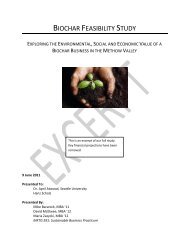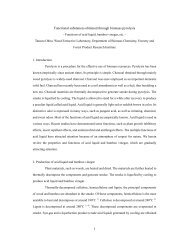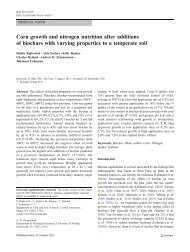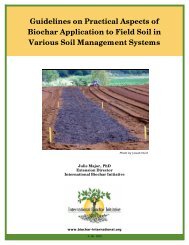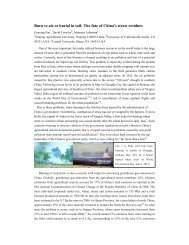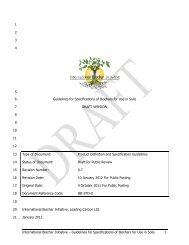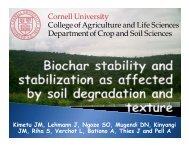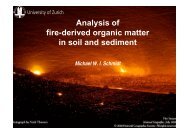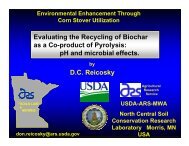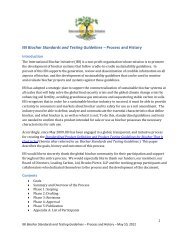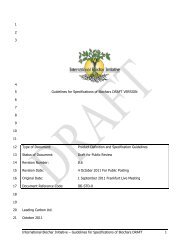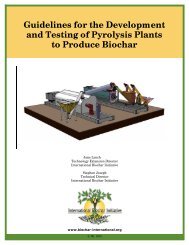Effects of Rice Husk Biochar Produced under Slow Pyrolysis on ...
Effects of Rice Husk Biochar Produced under Slow Pyrolysis on ...
Effects of Rice Husk Biochar Produced under Slow Pyrolysis on ...
You also want an ePaper? Increase the reach of your titles
YUMPU automatically turns print PDFs into web optimized ePapers that Google loves.
Nati<strong>on</strong>al Pingtung University <str<strong>on</strong>g>of</str<strong>on</strong>g> Science and Technology<br />
Pingtung, Taiwan.<br />
Odette Varela Milla<br />
Wu-Jang Huang PhD.
C<strong>on</strong>tents:<br />
• Objectives<br />
• Introducti<strong>on</strong><br />
• Characteristics <str<strong>on</strong>g>of</str<strong>on</strong>g> carb<strong>on</strong>ized rice residues<br />
• <str<strong>on</strong>g>Biochar</str<strong>on</strong>g> preparati<strong>on</strong> and characterizati<strong>on</strong><br />
• Scanning electr<strong>on</strong> microscopy analysis<br />
• Water spinach<br />
• Worm avoidance test<br />
• Soil<br />
• Applicati<strong>on</strong> <str<strong>on</strong>g>of</str<strong>on</strong>g> rice husk biochar and wood<br />
biochar to soil<br />
• Results<br />
2
Objectives:<br />
• Realize an investigati<strong>on</strong> <str<strong>on</strong>g>of</str<strong>on</strong>g> the short-term effects<br />
related to slow pyrolysis biochar effects in plant<br />
growth.<br />
• Furthermore it is planned to determine biochar<br />
characteristics such as biodegradability, porosity and<br />
cati<strong>on</strong> exchange capacity, produced from agricultural<br />
waste.<br />
3
Organic waste as feedstock for biochar producti<strong>on</strong><br />
• Many different materials have been proposed as biomass<br />
feedstocks for biochar, including wood, grain husks, nut<br />
shells, manure and crop residues, (Lua et al., 2004, Martinez et<br />
al., 2006, G<strong>on</strong>zaléz et al., 2009).<br />
4
• The use <str<strong>on</strong>g>of</str<strong>on</strong>g> rice straw and rice husk has been practiced for a l<strong>on</strong>g<br />
time (P<strong>on</strong>amperuma, 1982; Eagle et al., 2000; Singh et al., 2008;<br />
Kaewpradit et al., 2009).<br />
• Karmakar et al., (2009) studied the effect <str<strong>on</strong>g>of</str<strong>on</strong>g> applicati<strong>on</strong> <str<strong>on</strong>g>of</str<strong>on</strong>g> fly ash<br />
and rice husk ash, the study showed that the applicati<strong>on</strong> <str<strong>on</strong>g>of</str<strong>on</strong>g> these<br />
type <str<strong>on</strong>g>of</str<strong>on</strong>g> waste improved soil properties by decreasing soil bulk density<br />
and increasing soil pH, organic carb<strong>on</strong>, available nutrients, and crops<br />
yield.<br />
5
• The total amount <str<strong>on</strong>g>of</str<strong>on</strong>g> crop residues produced each year in rice-based<br />
systems <str<strong>on</strong>g>of</str<strong>on</strong>g> Asia can be roughly estimated at about 112 milli<strong>on</strong> t<strong>on</strong>s <str<strong>on</strong>g>of</str<strong>on</strong>g><br />
rice husks (based <strong>on</strong> 2005 producti<strong>on</strong> and a husk/paddy ratio <str<strong>on</strong>g>of</str<strong>on</strong>g> 0.2).<br />
(Pandey 1998)<br />
Asia and China <str<strong>on</strong>g>Rice</str<strong>on</strong>g> Producti<strong>on</strong> 2008<br />
Source: http://www.fao.org/corp/statistics/en/<br />
• Residue burning is widely practiced and causes air polluti<strong>on</strong>, human<br />
health problems, and c<strong>on</strong>siderable nutrient losses.<br />
6
Taiwan’s cultivated land area<br />
250000<br />
0.14%<br />
Hectares<br />
200000<br />
150000<br />
100000<br />
50000<br />
0.64%<br />
0.34%<br />
99.36% 99.66% 99.86%<br />
0.54%<br />
99.46%<br />
0<br />
<str<strong>on</strong>g>Rice</str<strong>on</strong>g> Vegetable Fruits Tea Others<br />
s<br />
crops<br />
Organic (ha) 949.44 518.43 295.52 139.84 453.1<br />
96.66%<br />
No organic (ha) 147081.56 151573.57 215067.48 25647.16 13107.9<br />
3.34%<br />
Source: Organizati<strong>on</strong> <str<strong>on</strong>g>of</str<strong>on</strong>g> certificati<strong>on</strong> Agriculture and Food Agency ,Council <str<strong>on</strong>g>of</str<strong>on</strong>g> Agriculture. 2009
Characteristics <str<strong>on</strong>g>of</str<strong>on</strong>g> Carb<strong>on</strong>ized <str<strong>on</strong>g>Rice</str<strong>on</strong>g> Residues<br />
• Carb<strong>on</strong>ized rice husks are a very light material with a<br />
microporous structure and a bulk density <str<strong>on</strong>g>of</str<strong>on</strong>g> about 0.150 g cm−3<br />
(Nakajima 1986).<br />
• The structure <str<strong>on</strong>g>of</str<strong>on</strong>g> rice husks is preserved in the carb<strong>on</strong>izati<strong>on</strong><br />
process but carb<strong>on</strong>ized husks break easily, especially if<br />
carb<strong>on</strong>ized at high temperatures.<br />
8
<str<strong>on</strong>g>Biochar</str<strong>on</strong>g> preparati<strong>on</strong> and characterizati<strong>on</strong><br />
• <str<strong>on</strong>g>Biochar</str<strong>on</strong>g> was found to be alkaline in nature (pH 8.2). <str<strong>on</strong>g>Rice</str<strong>on</strong>g> husk biochar<br />
produced <str<strong>on</strong>g>under</str<strong>on</strong>g> temperatures between 500 and 600 ℃, showed a<br />
noticeable increment in silic<strong>on</strong>, calcium, potassium and magnesium<br />
c<strong>on</strong>tent.<br />
9
Scanning electr<strong>on</strong> microscope analysis<br />
• The EDS point analysis <str<strong>on</strong>g>of</str<strong>on</strong>g> rice husk indicated that the biochar<br />
particles c<strong>on</strong>sisted <str<strong>on</strong>g>of</str<strong>on</strong>g> high silic<strong>on</strong> mineral agglomerates <strong>on</strong> lower<br />
carb<strong>on</strong> c<strong>on</strong>tent fibers with structures typical <str<strong>on</strong>g>of</str<strong>on</strong>g> its biomass<br />
origin<br />
10
• Wood biochar EDS point analysis, indicated that the biochar<br />
particles c<strong>on</strong>sisted <str<strong>on</strong>g>of</str<strong>on</strong>g> high potassium, chlorine, and calcium.<br />
• Mineral agglomerates also showed high carb<strong>on</strong> c<strong>on</strong>tent<br />
12
To investigate and quantify effects <str<strong>on</strong>g>of</str<strong>on</strong>g> rice husk-based<br />
biochar and wood-based biochar <strong>on</strong> the growth <str<strong>on</strong>g>of</str<strong>on</strong>g> water<br />
spinach, a field experiment was carried out <str<strong>on</strong>g>under</str<strong>on</strong>g> different<br />
treatments, c<strong>on</strong>sisting <str<strong>on</strong>g>of</str<strong>on</strong>g>:<br />
•(1) c<strong>on</strong>trol soil and fertilizer,<br />
•(2) soil with rice husk biochar and fertilizer in five<br />
different quantities,<br />
•(3) and soil with wood biochar and fertilizer in five<br />
different quantities.<br />
14
From the literature, the recommends amount <str<strong>on</strong>g>of</str<strong>on</strong>g> rice husk biochar<br />
that should be applied is: 10 t<strong>on</strong> per hectare (<str<strong>on</strong>g>Biochar</str<strong>on</strong>g> and Carb<strong>on</strong><br />
Sequestrati<strong>on</strong>, a regi<strong>on</strong>al perspective, 2009).<br />
1.10 m<br />
1.94 m
Water spinach<br />
• Water c<strong>on</strong>volvulus has been widely grown throughout the world. It is<br />
found in South and Southeast Asia, Tropical Africa, South<br />
America, and Oceania (Wenfang, 1997). However, it is <strong>on</strong>ly in south<br />
and Southeast Asia that it is an important leafy vegetable.<br />
http://waynesword.palomar.edu/ww0804.htm<br />
16
Worm avoidance test<br />
• A toxicity test was c<strong>on</strong>ducted before starting the biochar<br />
experiment. Following the guidelines from “A guide to<br />
c<strong>on</strong>ducting biochar trials” (Major. J., 2009) we realized a<br />
worm avoidance test<br />
17
• We made our trial with 50 worms that were purchased in a fish<br />
shop<br />
• The c<strong>on</strong>tainer was prepared with rice husk biochar and soil from<br />
the experimental field. We had as a result that most <str<strong>on</strong>g>of</str<strong>on</strong>g> the<br />
worms shown an acceptance for rice husk biochar<br />
18
Soil<br />
• The experiment was<br />
c<strong>on</strong>ducted <strong>on</strong> an<br />
uncultivated clayey Ultisol<br />
soil, which are str<strong>on</strong>gly<br />
leached, acid forest soils<br />
with relatively low native<br />
fertility.<br />
http://eusoils.jrc.ec.europa.eu/esdb_archive/eudasm/asia/maps/TW3000_1SO.htm<br />
19
• Germinati<strong>on</strong> comparis<strong>on</strong> between Soil field with <str<strong>on</strong>g>Biochar</str<strong>on</strong>g> and<br />
soil field without biochar<br />
• Soil with biochar shows the best germinati<strong>on</strong><br />
20
Applicati<strong>on</strong> <str<strong>on</strong>g>of</str<strong>on</strong>g> rice husk biochar and wood<br />
biochar to soil<br />
• Soil preparati<strong>on</strong><br />
21
• <str<strong>on</strong>g>Biochar</str<strong>on</strong>g>s were weighted and later added to each <strong>on</strong>e <str<strong>on</strong>g>of</str<strong>on</strong>g> the<br />
plots<br />
22
• Top soil mixing technique (Major, 2009)<br />
• Before transplanting was necessary to irrigate for 10 minutes<br />
• Following the literature recommendati<strong>on</strong>s, plants were transplanted<br />
in a distance <str<strong>on</strong>g>of</str<strong>on</strong>g> 15cm between them.<br />
• Each plot had 22 plants<br />
23
Morphology<br />
• Leaf number<br />
• Leaf length and wide<br />
• Stem size<br />
• Stem number<br />
• Root size<br />
• Weight<br />
24
Results:<br />
• Water spinach plants for all <str<strong>on</strong>g>of</str<strong>on</strong>g> the c<strong>on</strong>sidered treatments were<br />
harvested after 8 weeks.<br />
25
Effect <str<strong>on</strong>g>of</str<strong>on</strong>g> rice husk biochar and wood biochar <strong>on</strong> plant<br />
root growth<br />
• All water spinach plants were measured before harvesting;<br />
carefully plants and roots were removed from soil.<br />
27
Statistical analysis<br />
• Both biochar treatments where compared using least<br />
significant difference (LSD), for their main effects<br />
<strong>on</strong> plant growth properties (SAS 9.1, 2004).<br />
29
Leaf wide (mm)<br />
Leaf number<br />
Leaf length (mm)<br />
Leaf length (mm)<br />
<str<strong>on</strong>g>Rice</str<strong>on</strong>g> husk<br />
Wood<br />
40<br />
30<br />
20<br />
20<br />
15<br />
10<br />
5<br />
0<br />
10<br />
0 1 2 3 4 5<br />
Treatments<br />
0<br />
0 1 2 160 3 4 5<br />
Treatments 140<br />
<str<strong>on</strong>g>Rice</str<strong>on</strong>g> husk<br />
Wood<br />
120<br />
100<br />
80<br />
60<br />
40<br />
20<br />
0<br />
160<br />
140<br />
120<br />
100<br />
<str<strong>on</strong>g>Rice</str<strong>on</strong>g> husk<br />
Wood<br />
80<br />
0 1 2 3 4 5<br />
60<br />
Treatments<br />
40<br />
20<br />
0<br />
0 1 2 3 4 5<br />
Treatments<br />
<str<strong>on</strong>g>Rice</str<strong>on</strong>g> husk<br />
Wood<br />
31
Stem number<br />
Stem size (mm)<br />
<str<strong>on</strong>g>Rice</str<strong>on</strong>g> husk<br />
Wood<br />
3.5<br />
3.0<br />
2.5<br />
2.0<br />
1.5<br />
1.0<br />
0.5<br />
0.0<br />
0 1 2 3 4 5<br />
Treatments<br />
200<br />
<str<strong>on</strong>g>Rice</str<strong>on</strong>g> husk<br />
Wood<br />
150<br />
100<br />
50<br />
0<br />
0 1 2 3 4 5<br />
Treatments<br />
32
• Randomly we choose water spinach plants from each<br />
treatment, T1, T2, T3, T4, T5, treated with each <strong>on</strong>e <str<strong>on</strong>g>of</str<strong>on</strong>g> the biochars.<br />
33
Root size (mm)<br />
<str<strong>on</strong>g>Rice</str<strong>on</strong>g> <str<strong>on</strong>g>Husk</str<strong>on</strong>g><br />
Wood<br />
150<br />
100<br />
50<br />
0<br />
0 1 2 3 4 5<br />
Treatments<br />
34
Effect <str<strong>on</strong>g>of</str<strong>on</strong>g> rice husk biochar and wood biochar <strong>on</strong><br />
plant fresh weight<br />
• From each treatment, plants were collected<br />
• All plants were classified by treatment<br />
• Plants were weighted<br />
35
Weight (kg)<br />
0.6<br />
<str<strong>on</strong>g>Rice</str<strong>on</strong>g> <str<strong>on</strong>g>Husk</str<strong>on</strong>g><br />
Wood<br />
0.5<br />
0.4<br />
0.3<br />
0.2<br />
0.1<br />
0.0<br />
0 1 2 3 4 5<br />
Treatments<br />
36
C<strong>on</strong>clusi<strong>on</strong>s<br />
•<str<strong>on</strong>g>Rice</str<strong>on</strong>g> husk biochar showed better holding capacity than wood<br />
based biochar, due to the differences in their particle size, rice<br />
husk biochar was able to integrate better into soil making the<br />
distributi<strong>on</strong> more uniform.<br />
•Water spinach requires plenty <str<strong>on</strong>g>of</str<strong>on</strong>g> water because <str<strong>on</strong>g>of</str<strong>on</strong>g> its high<br />
succulence, regardless <str<strong>on</strong>g>of</str<strong>on</strong>g> this informati<strong>on</strong>, we irrigated the<br />
plants every 2 days for <strong>on</strong>ly 10 minutes.<br />
•The plants were able to absorb the water that biochar was<br />
retaining, being not affected by the lack <str<strong>on</strong>g>of</str<strong>on</strong>g> water.<br />
39



